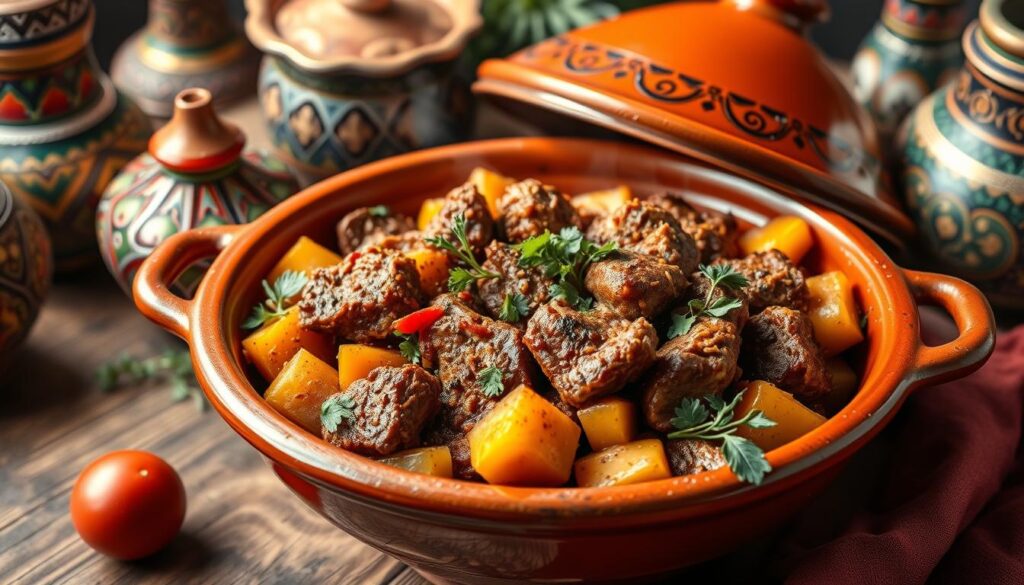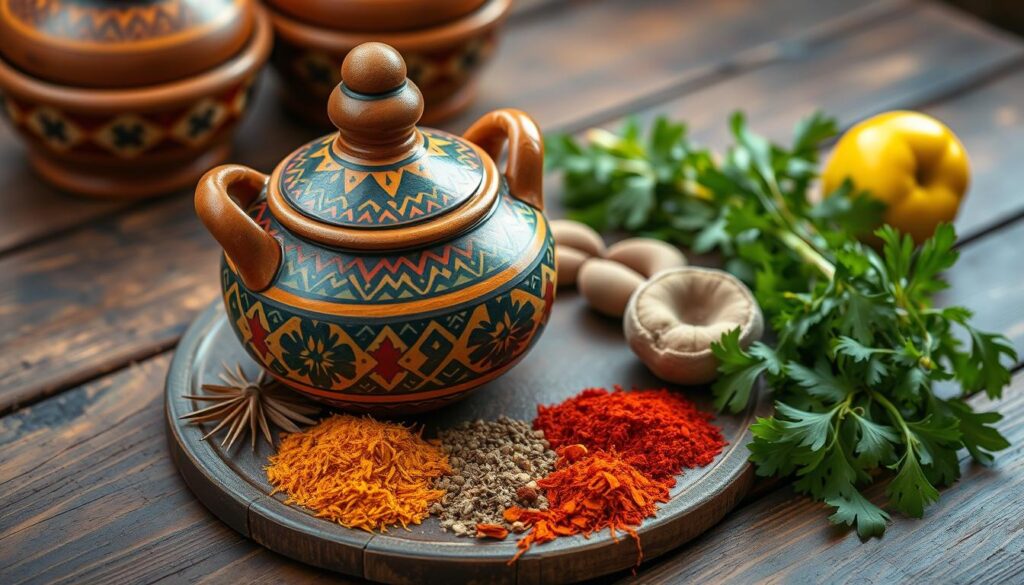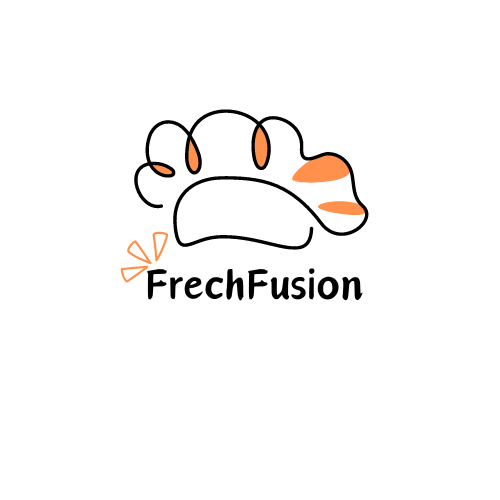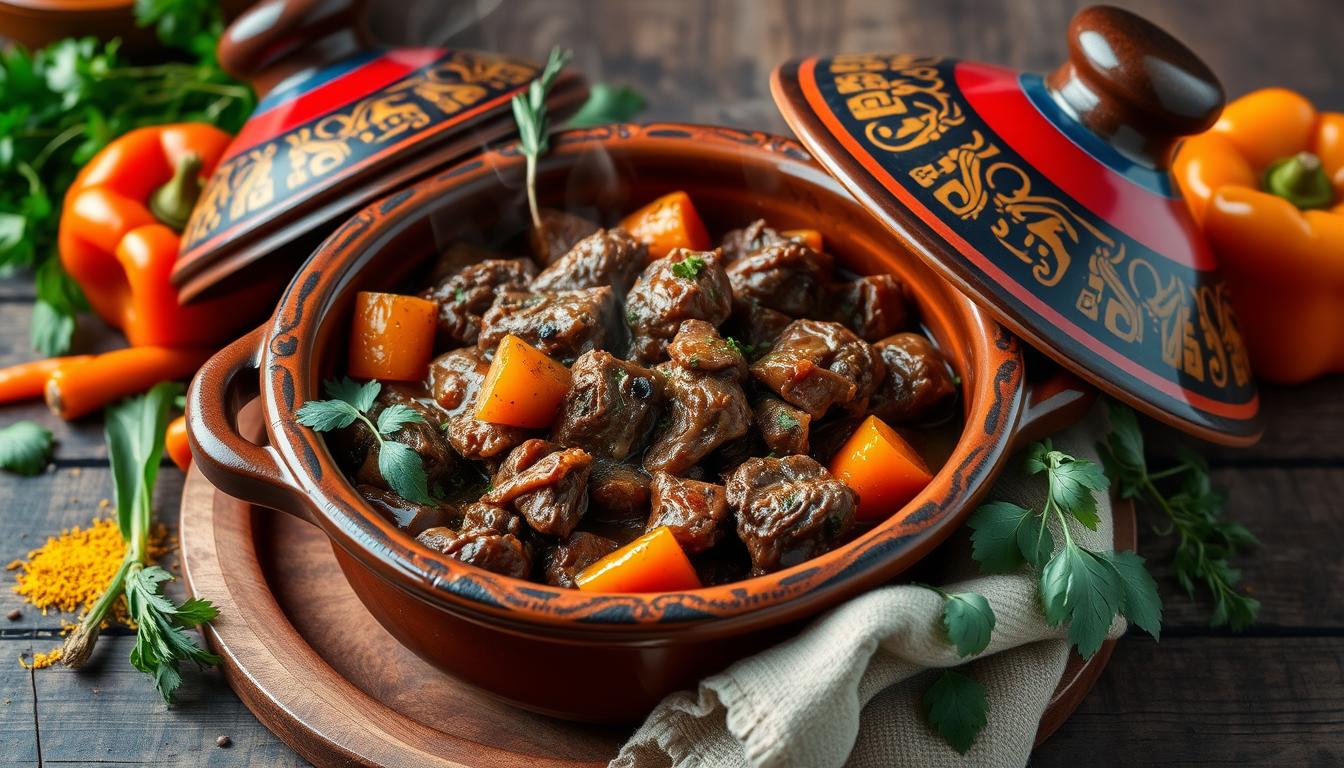As the sun sets, the smell of spices and meat fills the air. It invites you to explore Morocco’s rich flavors. The tagine, a traditional clay pot, is key to Moroccan cooking. It brings a world of tastes to your table, like Marrakech’s streets.
Picture a dish where beef or lamb just melts in your mouth. Each bite is full of spices, caramelized onions, and sweet tomatoes. This is the Moroccan Meat Tagine, a dish loved for generations. Each family adds their own twist to this classic.
Table of Contents
Unraveling the Secrets of Moroccan Cuisine
Get ready for a food journey through Morocco’s rich flavors. You’ll explore Marrakech’s lively souks and Fez’s ancient Medinas. Discover Morocco’s vibrant food culture.
Exploring the Rich History and Diverse Flavors
Moroccan food is a mix of cultures, shaped over centuries. Spices, tagines, pastries, and mint tea have won hearts worldwide. This trip will excite your taste buds and make you want more.
Tagine, Morocco’s famous dish, comes in many flavors like chicken, lamb, and veggies. Ras el Hanout seasoning mix, with up to 30 spices, adds depth to every bite.
Moroccan street food is a treat, with Maakouda, B’stilla, and kebabs. Sharing mint tea shows the importance of hospitality and tradition in Morocco.

From Essaouira and Agadir’s seafood to the Berber, Arab, and Andalusian tastes, Moroccan food is a mix of traditions. Try Baklava, Ghriba cookies, and Harira soup. This food adventure will deepen your love for Moroccan cuisine’s history and flavors.
The Art of Tagine, Moroccan Clay Pot Cooking
Mastering the Traditional Clay Pot Technique
Moroccan cuisine is famous for its meat tagine dishes. These dishes mix proteins, vegetables, and spices in a flavorful way. The traditional Moroccan clay pot, or tagine, is at the heart of this tradition.
Learning to cook with a Moroccan tagine starts with knowing the clay pot. These pots trap steam, keeping food moist and flavorful. This method gives food a unique taste that other cooking can’t match.
Whether you’re making a Makfoul Meat tagine or trying new vegetables, the right tools matter. With practice, you can make authentic Moroccan tagine dishes. This brings the rich flavors of Moroccan cooking into your home.
“Tagines are not just a dish, but a way of life in Moroccan cuisine, where flavors are allowed to meld and mingle, creating a harmonious feast for the senses.”
Start your journey in Moroccan clay pot cooking, tagine. Let the traditional Moroccan clay pot coking technique take you to Morocco’s markets and streets. Enjoy every delicious bite.

Moroccan food recipes, meat tagine, tagine spices, tagines food
Moroccan cuisine is famous for its bold flavors and wide variety of dishes. The tagine is at the center of its cooking traditions. Moroccan tagines range from tender meats to fragrant vegetable stews, all delicious and authentic.
Learning to cook tagine is key to enjoying Moroccan food. It involves using spices like cumin, cinnamon, and ras el hanout. Whether you make a classic beef or lamb tagine or try a veggie version, you’ll love the real tastes of Morocco.
| Recipe | Prep Time | Cook Time | Total Time | Servings |
|---|---|---|---|---|
| Moroccan Meat Tagine | 15 minutes | 1 hour 30 minutes | 1 hour 45 minutes | 4-6 people |
To make a true Moroccan meat tagine, you need special spices. Use cumin, coriander, cinnamon, ginger, and ras el hanout. Add tender beef or lamb, colorful veggies, and dried fruits like apricots and raisins for a standout dish.
Slow-cooking is crucial for the tagine texture. It lets the flavors mix and the meat get tender. Use a clay tagine pot or a Dutch oven. The result is a true taste of Moroccan cuisine, taking you to the lively souks and markets of Morocco.
Spice up Your Life with Ras el Hanout
Ras el hanout is at the core of Moroccan cooking. It’s a mix of up to 30 spices that adds depth to dishes. This blend includes cumin for smokiness and cinnamon for warmth, making Moroccan food special.
Adding ras el hanout to your recipes brings out the true taste of North African food. It combines spices like cardamom, cloves, and rose petals for a balanced flavor. It makes even simple dishes taste amazing, like a Moroccan beef tagine or vegetable couscous.
Discover the rich flavors of Moroccan cuisine with ras el hanout. Try new recipes and see how it can change simple ingredients into something special. Whether it’s a slow-cooked tagine or a fragrant rice dish, ras el hanout opens up endless possibilities. Let it take you on a journey of Moroccan flavors and aromas.
“Ras el hanout is the heart and soul of Moroccan cuisine. It’s the spice that brings everything together, creating a symphony of flavors in every bite.”
– Fatima, Moroccan Chef
| Ras el Hanout Spice Blend Ingredients | Flavor Profile |
|---|---|
| Cardamom, Cloves, Nutmeg, Rose Petals | Warm, Floral, Fragrant |
| Cumin, Coriander, Cinnamon | Earthy, Smoky, Aromatic |
| Ginger, Turmeric, Chili Peppers | Spicy, Pungent, Vibrant |
Slow-Cooked Perfection: The Makfoul Beef Tagine
Get ready for a flavorful journey into Moroccan cuisine with the makfoul beef tagine. This slow-cooked Moroccan beef stew showcases the art of making traditional Moroccan tagine. Each bite reveals the rich, complex flavors.
The name “Makfoul” highlights the slow-cooking method. It keeps the aromas in and lets the ingredients blend perfectly. Beef or lamb, caramelized onions, and juicy tomatoes cook with spices like ras el hanout, cinnamon, and ginger. It’s a feast for the senses, whether cooked in a clay tagine or a Dutch oven.
The secret to this traditional Moroccan tagine recipe is slow, careful cooking. As the flavors mix and grow, you get a dish that’s both delicious and satisfying. It feels like a trip to Morocco’s lively markets and streets.
Try the makfoul beef tagine for slow-cooked perfection. It’s a taste of Moroccan culinary tradition.
Vegetable Variations and Accompaniments
While meat tagines like the Makfoul are stars in Moroccan cuisine, there’s a world of moroccan vegetable tagine and moroccan tagine side dishes. Moroccan cooks are experts at bringing out the best in seasonal produce. They make dishes like okra and artichoke tagines and the famous moroccan couscous recipes.
Looking for something sweet and savory? Try prunes and almonds. Or go for the classic tomatoes and onions. These pair well with fluffy couscous, fresh salads, and mint tea. It’s a true taste of Moroccan tradition.
| Moroccan Vegetable Tagine Variations | Traditional Moroccan Accompaniments |
|---|---|
|
|
Exploring moroccan vegetable tagine, moroccan tagine side dishes, and traditional moroccan accompaniments opens a world of flavors. It’s a true taste of Moroccan cuisine.
“Moroccan cuisine is internationally renowned for its use of spices and slow cooking techniques.”
Cooking Vessels: Tagine or Dutch Oven?
Choosing the right cooking vessel is crucial for a perfect Moroccan tagine. The traditional clay tagine is loved for its ability to keep flavors locked in. It makes the meat tender. But, a Dutch oven can also work well as a substitute.
Both the tagine and Dutch oven use slow simmering to blend flavors. Terracotta tagines were tested for two braised meat dishes, priced from $30 to $306. Glazed ceramic tagines cost between $100 to $187 and are dishwasher-safe, perfect for bigger meals.
The best cast iron tagines are priced around $60 to $90. They are durable and perform well. The vent holes in tagines help reduce liquid, making flavors more intense. Cast iron tagines are more versatile than terracotta or ceramic.
For tagine lids, the conical shape is key for moisture circulation. A tight fit is important for steam sealing. Glazed ceramic tagines are easier to clean and safe for the oven up to 500°F.
Mastering Moroccan tagine cooking techniques is essential. It unlocks the complex, aromatic wonders of this North African dish.
Exploring Regional Specialties
Morocco is a country full of vibrant regions, each with its own special foods. These dishes show off the area’s history, ingredients, and culture. From Marrakech’s busy souks to Fez’s ancient city and Tangier’s port, you’ll find a world of flavors and traditions.
Marrakech’s Mouthwatering Street Food
In Marrakech, the souks and medinas are alive with street food. You’ll smell grilled meats, fresh juices, and spices everywhere. It’s a feast for your senses, inviting you to try the marrakech moroccan cuisine.
Whether it’s a juicy kebab or a refreshing mint tea, Marrakech’s flavors will take you on a journey. It’s a culinary adventure you won’t forget.
The Treasures of Fez’s Culinary Traditions
Fez is Morocco’s cultural and spiritual heart. It’s known for its family-run restaurants and traditional fez moroccan food culture. You’ll find delicious tagines and harira soup, each dish a piece of history.
Fez’s rich flavors and aromas have been passed down for generations. It’s a chance to experience authentic Moroccan food.
Tangier’s Captivating Culinary Confluence
Tangier is where Moroccan and Mediterranean flavors meet. Here, you can try smoky sardines, vibrant salads, and more. It’s a place where tangier moroccan gastronomy comes alive.
Exploring Tangier’s food scene is a journey of discovery. It’s where regional moroccan culinary traditions shine in every bite.
Exploring Morocco’s regional specialties is key to understanding its cuisine. From Marrakech’s streets to Fez’s charm and Tangier’s coast, each place offers a unique culinary adventure. You’ll leave wanting more.
Moroccan Cooking Classes: Unleash Your Inner Chef
For those eager to dive into Moroccan cooking, Moroccan cooking classes are ideal. Expert instructors lead these workshops, showing you the secrets of Moroccan cuisine. You’ll learn about traditional cooking methods, like making tagines and blending spices.
Not only will you learn to make dishes like couscous and harira soup, but you’ll also understand their cultural importance. Whether you’re an experienced cook or just starting out, a Moroccan cooking class will spark your interest in North African flavors.
These Moroccan cooking workshops cost just 30€ per person. You’ll get a 3-course lunch to enjoy, all for a great price. With a maximum of 8 students, the classes are intimate and hands-on, led by Chef Laila with over 30 years of experience.
During the class, you’ll also get recipes via WhatsApp. This lets you make the dishes at home and continue your Moroccan culinary experiences. These Moroccan cooking classes offer a unique mix of learning, culture, and delicious food.
The Vibrant Souks: A Feast for the Senses
Discovering the Spice Markets of Morocco
Walking into the Moroccan souks is like entering a new world. It’s a feast for your senses, showing you the heart of Morocco’s culinary heritage. The air is filled with the smells of spices, from cumin’s earthy scent to cinnamon’s warm fragrance.
As you wander through the stalls, you’ll see a rainbow of spices. These colors and smells are key to making Morocco’s famous dishes.
The souks are more than just spices. You’ll find fragrant teas and sweet pastries too. Exploring these marketplaces lets you truly feel Morocco’s food culture.
“The souks of Morocco are a sensory delight, where the aroma of spices and the vibrant colors of the stalls create an unforgettable culinary experience.”
Whether you’re in Marrakech, Fez, or Tangier, the Moroccan food shopping is unforgettable. It leaves a lasting mark on your culinary experiences.
Conclusion
Exploring authentic Moroccan cuisine is a journey for your senses. It takes you to the lively markets, busy medinas, and cozy kitchens of Morocco. Here, you’ll find dishes like the slow-cooked Makfoul beef tagine and the fragrant ras el hanout.
Whether you’re cooking tagines at home, touring the country’s food scenes, or wandering spice souks, there’s much to discover. Let your senses lead you on this exciting Moroccan cooking journey.
Moroccan food is a mix of Berber, Arab, and colonial flavors. It’s a unique and delicious blend. Enjoy the tender meats, the aromatic spices, and the sweet and savory flavors. You’ll be swept into a world of taste that will touch your heart and palate.

